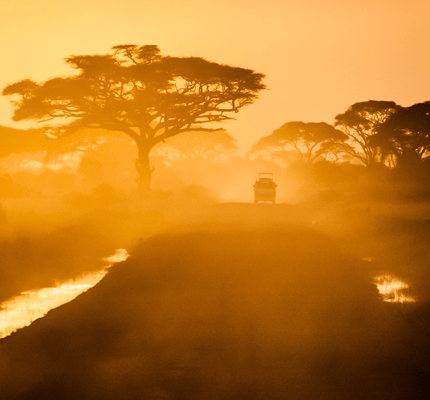
The African Celebrity Safari: Dream Vacation, or Racialized Aura?
Countless celebrities have publicized and promoted their trips to Africa, whether when part of a UN Goodwill ambassador excursion, filming on location, singing in a concert, or honeymooning. “The celebrity world is enchanted by Africa,” writes Katherine Bell in a recent article in Communication and Critical/Cultural Studies. Of all the adventures of wealthy celebrities to Africa, the celebrity safari is the one that is perhaps the strongest contributor to what Bell calls a “racial aura” that “imbues cult value and maintains transnational racial divides.”
In the article, Bell explores two tropes seen consistently throughout celebrity safari imagery: Africa as animals, and Africa as nostalgic luxury paradise. Her analysis includes a collection of photos from a safari taken by Oprah Winfrey, Instagram photos from a staged safari shoot with Rihanna, safari photos taken by Ellen DeGeneres on a family vacation, and imagery and themes depicted in Taylor Swift’s music video, “Wildest Dreams.” “These varied examples indicate the pervasiveness of the safari trope across celebrity media production and the wide reach of the images across television, social media, and other online locations,” Bell writes.
Explaining racial aura
When Western visitors travel to Africa, particularly celebrities, their stories and imagery recounting their trips solidify the notion that Africa is a place and an idea – on the one hand, full of famine, disease, and war; and on the other, a primitive, beautiful, and authentic landscape full of animals and no people – except the visitors. “This understanding of aura is useful in examining celebrity production of a racialized paradise that visitors embrace nostalgically,” Bell explains.
She acknowledges that colonial occupation is also a significant contributor to racial aura, and that celebrity and media have “long played a key role in Western understandings of Africa,” referencing films such as Out of Africa, The African Queen, and The English Patient. She argues that “the use of aura to reveal postracial obscuration of racial divides is part of an ongoing personal concern with the power of celebrity in relationship to race, class, and gender.” When celebrities counter their initial impressions of a continent ripe with death and disease with surprised declarations that Africa is lush, amazing, and real, they are perpetuating the characterization that Africa is a “cultural art work” available for “visitors to discover.” More damaging, Bell argues, the safari “inspires longing for a past that never was,” and that nostalgia only serves to perpetuate long-standing racial hierarchies.
Celebrity safari media: the analysis

In reviewing celebrity safari images from Ellen DeGeneres, Oprah Winfrey, and Rihanna, Bell notes the “visitor’s paradise” that is conjured up by commercial travel enterprises and reality TV – a paradise that only includes animals, and no residents, unless they are “props for the adventure tourist.” Oprah’s photos, taken by a guide, focus on the scenery and animals, conveying a sense of awe and beauty. Rihanna’s include staged shots of herself with the animals, but also in fashion model poses, using hashtags and captions that evoke a sense of wildness, hipness, and freedom. “She poses to suggest she belongs with the creatures, or perhaps is a creature dominating her surroundings,” the author writes.
Meanwhile, Ellen’s photos portray a family vacation, and her accompanying monologue on her TV show pushes an “awkward tourist for comedic effect” narrative, as well as promotion of her corporate partners, Shutterfly and Visa Checkout.
“All three celebrities exemplify an outside perspective as they ‘consume’ the animals touristically,” Bell writes. “The empty landscapes and wildlife signify primitive authenticity, disseminated by the cultural authority attached to their fame.”
However, Bell contends that Oprah’s and Rihanna’s images “derive authenticity from their racialized identities” as black celebrities. “These two women’s blackness operates as a symbol of nature and animals in the wild,” she argues. “Oprah’s economic and class privilege eclipses her marginalized identities of race and gender…yet her identity as a black woman serves an authenticating function that grants status to these depictions of Africa.”
Taylor Swift’s music video, on the other hand, models the nostalgic luxury playground motif. “Wildest Dreams” features a postwar safari film set, with Swift appearing as a femme fatale leading lady paired with a rugged leading man. Bell explains, “The video looks back with unabashed longing at a time when ideologies of whiteness knew no bounds and the sun never set on colonial empires. This Africa has an aura of golden beauty.” The video ultimately attracted criticism for both its blink-and-you-miss-it inclusion of black characters and its filter of nostalgia.
The commodification of racial aura and Africa
Through her analysis of the four celebrity safaris, Bell reasons that the images and video “illustrate celebrity constitution of racial aura that ritualizes Africa as a distant place for the purpose of consumption,” maintaining the idea that “Race is everywhere and nowhere at once.”
Celebrity safari imagery perpetuates the idea that Africa is a place unchanged by time or people, and that it is an eternal embodiment of the primitive side of nature. It builds a cult value that ritualizes a false sense of adventure and a longing for a real and authentic experience. In conclusion, Bell writes that the “real” Africa that is marketed to Western consumers relies upon social stratification and the ongoing narratives of nostalgia, beauty, and joy in the midst of misery, “trading on the authenticating value of race.”


